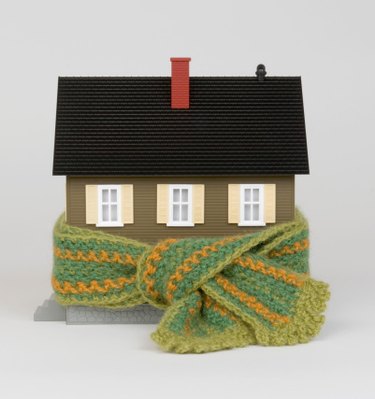Things You'll Need
Caulking gun
Silicone caulking
Styrofoam spray
Plastic sheeting
Scissors
Cardboard
Staple gun
Newspaper
Carbon monoxide detector

When temperatures drop outdoors, the thermostat rises -- along with the heating bill. Seal off those upstairs rooms in the winter to keep the heat from rising and make your utility bills more manageable. Temporary barriers, easily removed in the spring, keep warm air where you are most active in the home. Formulate a game plan to winterize your home from the attic to the basement, starting with the upper floors and working downward. Once you build a few basic fortifications against the cold, your weatherization schedule for winter becomes less complicated.
Step 1
Seal outside wall outlets with a bead of silicone caulking to keep cold air from coming in around the edges. If you don't want to use the caulking, cover the entire outlet with plastic.
Video of the Day
Step 2
Feel for drafts around window frames and upstairs balcony door frames. Seal the drafts with Styrofoam spray. Use caution during the application as the Styrofoam expands quickly and in large quantities.
Step 3
Cover crawl space or attic access doors with plastic. Fold the edges of the plastic over a strip of cardboard for more backing and staple through the plastic and cardboard to hold everything in place.
Step 4
Cut cardboard to the inside dimensions of the windows and plastic at least two inches wider and longer than the window frames. Place the cardboard against the window interior and secure with tape. Cover the window, frame included, with plastic that has cardboard wrapped in the edges. Staple the plastic sheeting into place.
Step 5
Locate the upstairs furnace vents and shut them so the heat is directed to the first floor of the house. Double check that you closed the right vents by turning on the furnace blower to see which vents shoot air.
Step 6
Close all the upstairs doors and insert folded newspaper under each door to close off any gaps near the threshold. Use newspaper to cover the exhaust vent in the upstairs bathroom, as well.
Step 7
Install a carbon monoxide detector in the first floor of your home. The chance of having unsafe levels of carbon monoxide increases with less air circulation in the home.
Tip
Make reusable window barriers by using wood lath instead of cardboard strips in the plastic and staple the plastic to the wood. To prepare for winter, place the barriers up to the window and secure with four brad nails. Contact your heating system manufacturer to determine the necessary air flow for proper ventilation prior to closing the vents.
Warning
Styrofoam spray is not easily removed and should only be used to seal small holes and cracks. It should never be used around outlets because it may bond with the wiring.
Video of the Day